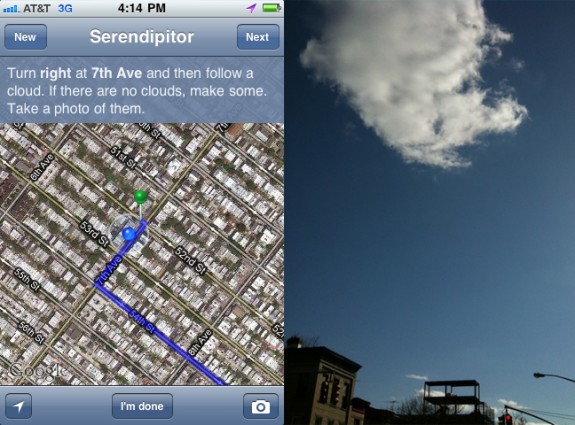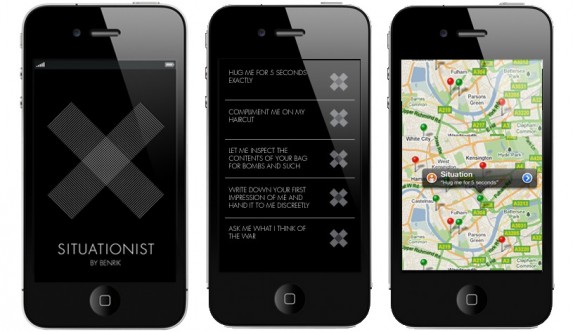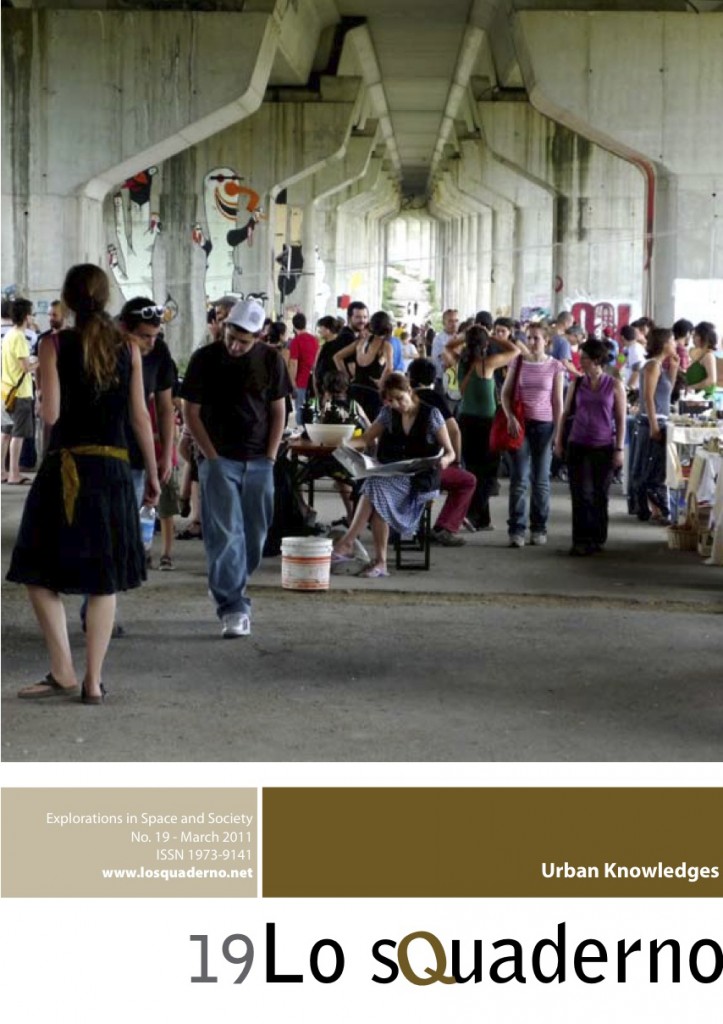App-Induced Spaces for Experimental Navigation and Interaction
March 20th, 2011

The bright and milder weather in New York City today enticed me to finally try out Mark Shepard’s celebrated Serendipitor, a navigation app for iPhone that helps you, as the slogan proclaims, “find something by looking for something else.” The application combines directions generated by Google Maps API to instructions for action and movement inspired by artists such as Vito Acconci, Yoko Ono and the Fluxus collective. It hacks the embedded “Maps” application and shifts its emphasis from fast and efficient “getting from A to B,” to the experience of the journey itself, one populated by serendipitous “action” events.
Upon mapping a route based on a random destination, I set out for my indeterminate journey. Serendipitor provided a series of instructions, some easy (get on a bus and ride for one stop, walk toward green traffic lights until you reach a red one, pick a person to follow for two blocks), some inspiring or poetic (follow a cloud, head toward the sound of traffic and take a photo of the sound, buy a flower and give it to someone) and some creepy or outside of my comfort zone (hitch a ride with a passing car and find out where it takes you, ask someone to take you to the part of town they are afraid of). I didn’t follow all instructions—it is hardly the point—but enjoyed the experience immensely. Most interesting was the realization of having stepped into a different—almost virtual— realm of navigation: free from everyday causality, productivity and social norms. Metaphorically speaking, I was inhabiting a different channel of reality, a different feed. I was engaging the city from without my comfortable habits, specific interests and ideas.
As a matter of fact, there was an uncanny component to the experience. More than inhabiting my own feed, it felt as if occupying someone else’s. At times, I had the impression of playing a video-game, of carrying out orders transmitted by some higher power pushing buttons on a joystick while stroking a cat; The streets and homes around me had become devoid of the contextual meaning that makes them real, and could disappear at any moment.
 Still from the movie Gamer
Still from the movie Gamer
These thoughts, along with the idea that in the future live instructions based on real-time encounters or on data picked up by the phone’s camera might be somewhat more accurate and engaging, reminded me of the movie Gamer. In the movie, evil genius Ken Castle invents a technology to link two human bodies so that one can remotely control the other like a real-world avatar. The technology is employed in two hit multi-player on-line games: “Slayers” and “Society.” The first one forces death row convicts to fight among themselves while being remotely controlled by teenage players, the second allows a sort of (un)mediated prostitution where the sexual service is performed not on the client him-/herself, but on the doppelgänger’s body. Without suggesting parallels between the movie’s dystopian games and Serendipitor, it is interesting to note a similar element of remote control, and wonder how future smart phone applications may serve not only as direct lenses to focus, distort and customize reality, but also as tools for controlling and being controlled, for psychotherapy, for trying out identities and role play.

Another interesting dimension of Serendipitor is that of interaction—interaction with strangers. However, if the user of Serendipitor engages unaware non-users— and the situation is therefore unilaterally defined and potentially awkward—a new app puts forward a different premise: that of complicity. Benrik’s Situationist is an iPhone app inspired by the Situationist International’s call for experimental forms of behavior and geared towards generating impromptu encounters. Users make up a profile by uploading their picture and selecting—or suggesting—situations they want to happen to them, from the friendly “Compliment my haircut” or “Hug me for 5 seconds exactly” to the more subversive “Help me rouse everyone around us into revolutionary fervor and storm the nearest TV station.” They are then notified of each other’s proximity in order to act out situations, which—beware— could occur anywhere and at any time. “Merely by having it on your phone—the creators maintain—your urban environment is transfigured: everyone you see is a potential encounter.” It is exciting to witness the rise of (free) tools for serendipity and experimental navigation and interaction, and to realize what a broad impact these tools can have in our perception of others and of the built environment. They remind us of the interconnectedness of all beings across socio-economic barriers and afford us a glimpse into a dimension of ourselves unbound by the routine of everyday survival.

